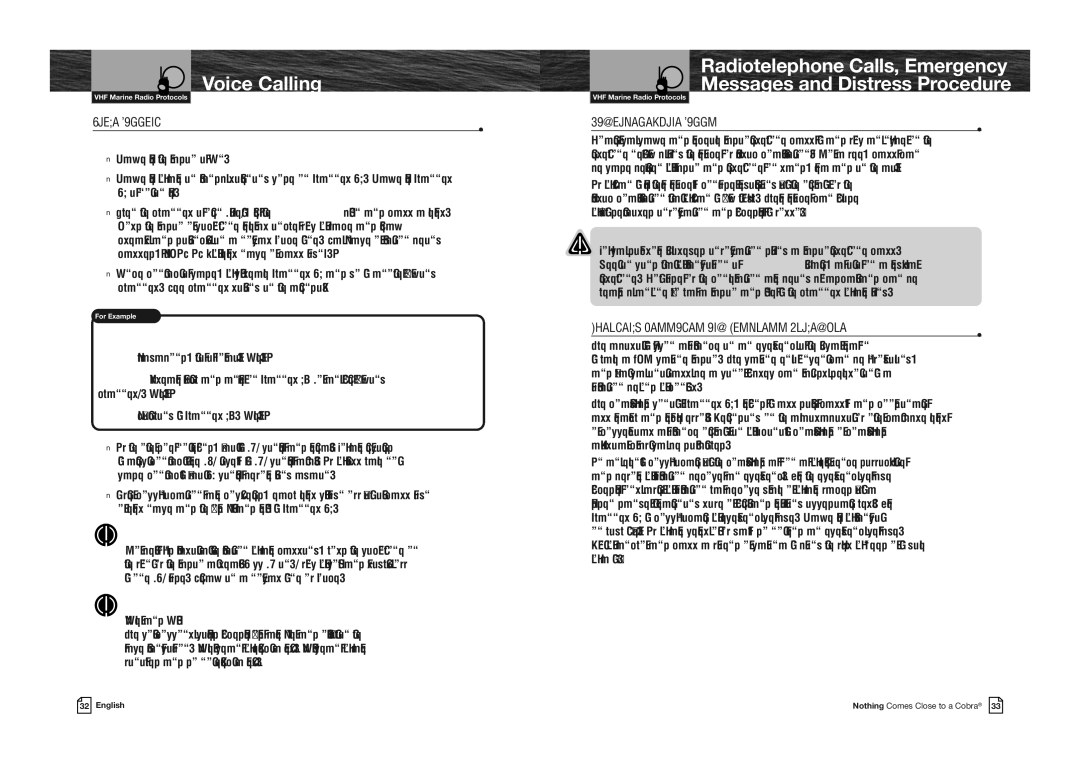
Voice Calling
VHF Marine Radio Protocols
Voice Calling
•
To call another vessel or shore installation (e.g, lock or bridge tender):
nMake sure the radio is On.
nMake sure you are in standby listening mode on Channel 16. Make sure Channel 16 is not in use.
nWhen the channel is open (quiet), press the Talk button and call a vessel. Hold the radio or microphone several inches from your face and speak clearly and distinctly in a normal voice tone. Say “name or station being called,” “THIS IS [your vessel name or call sign].”
nOnce contact is made, you must leave Channel 16 and go to another working channel. See channel listing in the appendix.
For Example
The vessel Corsair is calling the vessel Vagabond:
Corsair: “Vagabond, this is Corsair. Over.”
Vagabond: “Please switch and answer on Channel 68 (or any proper working channel). Over.”
Corsair: “Switching to Channel 68. Over.”
nIf the other does not respond, wait two (2) minutes and repeat. You are permitted to attempt contact three (3) times, two (2) minutes apart. If you still have not made contact, wait 15 minutes before trying again.
nAfter communications are completed, each vessel must sign off with its call sign or vessel name and the word “out” and return to Channel 16.
NOTE
For best sound quality at the station you are calling, hold the microphone on the front of the radio at least 51 mm (2 in.) from your mouth and slightly off to one (1) side. Speak in a normal tone of voice.
NOTE
“Over and Out”
The most commonly misused procedure words are “over and out” within the same transmission. “Over” means you expect a reply. “Out” means you are finished and do not expect a reply.
Radiotelephone Calls, Emergency
Messages and Distress Procedure
VHF Marine Radio Protocols
Radiotelephone Calls
•
Boaters may make and receive radiotelephone calls to and from any number on the telephone network by using the services of public coast stations. For a fee, calls can be made between your radio and telephones on land, sea and in the air.
If you plan to use these services, consider registering with the operator of the public coast station that you plan to work through. These services can provide you with detailed information and procedures to follow.
NOTICE
You may disclose privileged information during a radiotelephone call. Keep in mind that your transmission is NOT private, as it is on a regular telephone. Both sides of the conversation are being broadcast and can be heard by anyone who has a radio and tunes to the channel you are using.
Emergency Messages and Distress Procedure
•
The ability to summon assistance in an emergency is the primary reason to have a VHF marine radio. The marine environment can be unforgiving, and what may initially be a minor problem can rapidly develop into a situation beyond your control.
The coastguard monitors Channel 16, responds to all distress calls, and coordinates all search and rescue efforts. Depending on the availability of other capable vessels or commercial assistance operators in your vicinity, coastguard or coastguard auxiliary craft may be dispatched.
In any event, communicate with the coastguard as soon as you experience difficulties and before your situation becomes an emergency. Use the emergency message procedures only after your situation has become grave or you are faced with a sudden danger threatening life or property and requiring immediate help. Use Channel 16 to communicate your emergency message. Make sure you transmit on high power. If you are merely out of gas, do not send an emergency message. Drop your anchor and call a friend or marina to bring the fuel you need or to give you a tow.
|
|
|
|
32 English | Nothing Comes Close to a Cobra® 33 | ||
